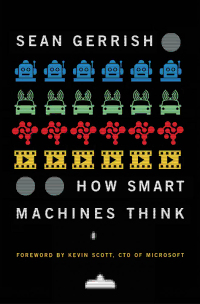Table Of ContentTitle Page Page: Cover Page
Copyright Page Page: iii
Dedication Page: iv
Table of Contents Page: v
Foreword by Kevin Scott, CTO, Microsoft Page: viii
Preface Page: x
Acknowledgments Page: xii
1. The Secret of the Automaton Page: xiv
2. Self-Driving Cars and the DARPA Grand Challenge Page: 7
3. Keeping within the Lanes: Perception in Self-Driving Cars Page: 271
4. Yielding at Intersections: The Brain of a Self-Driving Car Page: 273
5. Netflix and the Recommendation–Engine Challenge Page: 275
6. Ensembles of Teams: The Netflix Prize Winners Page: 277
7. Teaching Computers by Giving Them Treats Page: 279
8. How to Beat Atari Games by Using Neural Networks Page: 280
9. Artificial Neural Networks’ View of the World Page: 123
10. Looking Under the Hood of Deep Neural Networks Page: 282
11. Neural Networks that Can Hear, Speak, and Remember Page: 284
12. Understanding Natural Language (and Jeopardy! Questions) Page: 285
13. Mining the Best Jeopardy! Answer Page: 286
14. Brute-Force Search Your Way to a Good Strategy Page: 288
15. Expert-Level Play for the Game of Go Page: 290
16. Real-Time AI and StarCraft Page: 292
17. Five Decades (or More) from Now Page: 293
Index Page: 294
Description:Everything you've always wanted to know about self-driving cars, Netflix recommendations, IBM's Watson, and video game-playing computer programs. The future is here: Self-driving cars are on the streets, an algorithm gives you movie and TV recommendations, IBM's Watson triumphed on Jeopardy over puny human brains, computer programs can be trained to play Atari games. But how do all these things work? In this book, Sean Gerrish offers an engaging and accessible overview of the breakthroughs in artificial intelligence and machine learning that have made today's machines so smart. Gerrish outlines some of the key ideas that enable intelligent machines to perceive and interact with the world. He describes the software architecture that allows self-driving cars to stay on the road and to navigate crowded urban environments; the million-dollar Netflix competition for a better recommendation engine (which had an unexpected ending); and how programmers trained computers to perform certain behaviors by offering them treats, as if they were training a dog. He explains how artificial neural networks enable computers to perceive the world—and to play Atari video games better than humans. He explains Watson's famous victory on Jeopardy, and he looks at how computers play games, describing AlphaGo and Deep Blue, which beat reigning world champions at the strategy games of Go and chess. Computers have not yet mastered everything, however; Gerrish outlines the difficulties in creating intelligent agents that can successfully play video games like StarCraft that have evaded solution—at least for now. Gerrish weaves the stories behind these breakthroughs into the narrative, introducing readers to many of the researchers involved, and keeping technical details to a minimum. Science and technology buffs will find this book an essential guide to a future in which machines can outsmart people.

